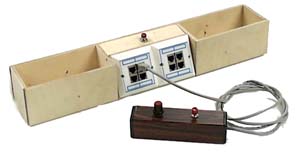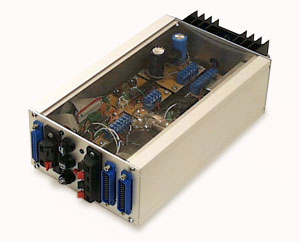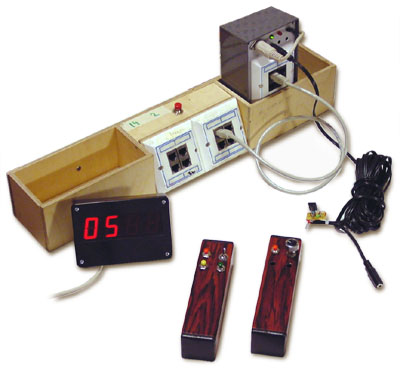
|
TaPRK General Projects Shows Excursions Links Yleistä Ratoja Projektit Näyttelyt Retket Linkit Parish/SRK |
Original TMWDCC control |

|


|
|
The controllers were connected to PC's joystick card and the PC's parallel port delivered NMRA-DCC data in 8-bit parallel form. Locos were assigned with keyboard commands to these controllers. With addition of another joystick card there were sockets for 8 controllers (we used four controllers and changed locos by changing the socket where the controller was plugged in. The TMWDCC hardware converted the 5-volt 8-bit parallel data into 14 volt serial square-wave NMRA-DCC signal.
1st version: Joystick replacement controllers |

|

|
|
The original IR-system replaced the throttles connected to joystick card. The cmos switches operated the resistor network and pressed the button. The IR receiver resistor networks were connected with interchangeable patch cables to controller sockets, thus replacing wired controllers potentiometer and dir. button The prototype throttles are presently on loan to Mr T.S.Knutsen of Drammen, Norway since August 2003 for testing in Høæstmesse in Oslo in September 2003.
1B version: Joystick replacement controllers w. functions to button version
2nd version: Joystick replacement controllers w. throttle selector (totally unfinished!) |

|
|
The cmos crosspoint choose the socket to which the resistor network (that replaces the original controllers pot) were plugged in.
3rd (present) version: PC replacement (PC-eliminator) |

|
|
The cmos crosspoint became so clumsy, so the whole desing was re-planned! The IR receiver processor will now deliver the 8-bit parallel data directly to TMWDCC hardware. The design makes the IR receiver processor less time critical than letting it do all the work! The controllers can now choose the loco they will operate!
All in all the Mk I setup did work during three day Model-Expo 2002! We have since Model-Expo 2002 used solely the Mk III system in exhibitions. It has some problems (needs pressing the address selector button from time to time).
27858 kävijää/visitors © 1996-2023 Tapiola Parish Model Railway Club / Tapiolan seurakunnan pienoisrautatiekerho, Viimeksi päivitetty / last modified (none). Created with Notepad. Text, drawings and photos are protected by copyright laws. Technical solutions, methods and source code are public domain only for non commercial purpose. All development has been carried out during our free time, mainly funded from our own pocket and with non selfish goals, so the use of this material for profitable use (including construction for a friend aginst a fee) is forbidden without written permit from the club. The pages contain errors, so, if you use the data given, you do so at your own risk and responsibility. If you further develop material found on these pages you must put it on display without fee e.g. to a freely available web page. We expect a note about this also. Pages tested with W3C validator -- didn't look good ;) [YHTEYSTIEDOT] Älä lähetä sähköpostia! Tekstit, kuvat ja piirokset ovat tekijänoikeuslain suojaamia. Tekniset ratkaisut, menetelmät ja lähdekoodit ovat vapaasti kopioitavissa ja hyödynnettävissä ei-kaupallisissa tarkoituksissa. Kaikki kehitystyö on tehty vapaa-aikana ja pääosin henkilökohtaisilla varoilla eikä hyötymistarkoituksessa, siksi materiaalin käyttö hyötymistarkoituksiin (sisältäen kaverille rahasta rakentamisen!) on kielletty ilman kerhon kirjallista lupaa! Sivuilla esiintyy virheitä. Jos käytät sivujen tietoja hyväksesi, teet sen täysin omalla vastuullasi. Mikäli kehität sivuilla esiettyjä ajatuksia kytkentäkaavioita tai koodia edelleen, on sinun asetettava se maksutta kaikkien saataville esimerkiksi Internetiin. Odotamme vastavuoroisesti tietoa suoritetusta edelleenkehitystyöstä. Sivut testattu W3C validatorilla -- ei näyttänyt hyvältä ;) |